Roden's 1/72nd SdKfz 232 (Fu) (8 Rad)
|
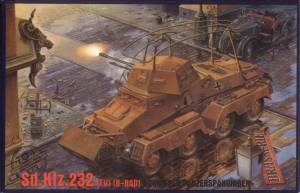 |
History
The SdKfz 232 was the command and control version of the SdKfz 231.
It differed from the SdKfz 231 only in the presence of the "bow"
antenna which was used for its wireless communications between cars.
Normally these were used in the reconnaissance role. Production of the
SdKfz 232 stopped in 1943 only because the SdKfz 234 (Puma) was introduced
and found to be a much better vehicle.
The Kit
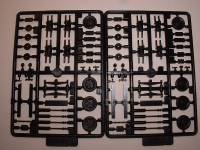 The
Roden SdKfz 232 (F8) (8 Rad) consists of 112 injected parts, some in
gray, the others in black. Decals exist for three different versions
of the 8 Rad: (1) a machine from the Fallshirm-Panzer Division "Hermann
Goering" in Italy, 1944; (2) a machine of the 5. "Wiking"
SS Panzer Division on the Eastern Front; and (3) a machine of the "Hermann
Goering" Motorized Brigade, Rumania. Decals appear sharp and and
differ from the first release of this series (the SdKfz 231) in that
the white and black of the crosses are separate decals, meaing those
crosses - which had some problems in the earlier kit - will look much
better this time around. Hooray for Roden! It definitely appears they
listen to their customers. The
Roden SdKfz 232 (F8) (8 Rad) consists of 112 injected parts, some in
gray, the others in black. Decals exist for three different versions
of the 8 Rad: (1) a machine from the Fallshirm-Panzer Division "Hermann
Goering" in Italy, 1944; (2) a machine of the 5. "Wiking"
SS Panzer Division on the Eastern Front; and (3) a machine of the "Hermann
Goering" Motorized Brigade, Rumania. Decals appear sharp and and
differ from the first release of this series (the SdKfz 231) in that
the white and black of the crosses are separate decals, meaing those
crosses - which had some problems in the earlier kit - will look much
better this time around. Hooray for Roden! It definitely appears they
listen to their customers.
There are 4 common sprues between the three vehicles so far released
by Roden - two of them for the undercarriage and some smaller parts
and one sprue that contains the main hull and larger pieces to adhere
to the hull. The additional sprue(s) contain that which "defines"
the vehicle. For the SdKfz 263 it was the new "mid" hull and
radio antenna (which contains part for the extra armor in front of the
vehicle); for the SdKfz 231 it was just the smaller turret that rotated;
and for the SdKfz 232 the extra sprues are for the smaller turret and
the radio antenna, plus extra front armor pieces.
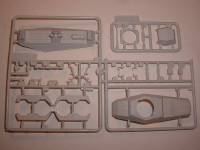 Construction
starts with building up the drive-train units. Each part of the suspension
consists of six parts per differential with five more parts connecting
each differential to make up a suspension unit. Four wheels are then
added to each suspension unit to create the 8 Rad. The instructions
show that a lot of parts aren't to be glued. From discussions with On
The Way! owner Doug Chaltry, it appears that if you follow Roden's guidelines
that the suspension will have some leaway, allowing the suspension to
conform to non-flat terrain. This means that all eight wheels should
remain flat on the ground at almost all times. An excellent show from
Roden. Construction
starts with building up the drive-train units. Each part of the suspension
consists of six parts per differential with five more parts connecting
each differential to make up a suspension unit. Four wheels are then
added to each suspension unit to create the 8 Rad. The instructions
show that a lot of parts aren't to be glued. From discussions with On
The Way! owner Doug Chaltry, it appears that if you follow Roden's guidelines
that the suspension will have some leaway, allowing the suspension to
conform to non-flat terrain. This means that all eight wheels should
remain flat on the ground at almost all times. An excellent show from
Roden.
From there construction moves to creating the turret, something that
doesn't appear too difficult. Roden allows not only the turret to rotate,
but also allows the main gun to traverse. A very nice touch. With the
SdKfz 232 you don't have to remove the "plates" where the
radio antenna go into since the radio antenna is meant for this version.
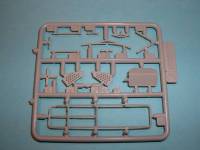 Now
construction moves to adding all of the small parts to each fender.
Having built the SdKfz 231 I didn't follow the instructions on this
aspect. Instead of adding the smaller parts to the fender before adding
the fenders to the body, you definitely want to add the small parts
after the fenders are on the body. Now
construction moves to adding all of the small parts to each fender.
Having built the SdKfz 231 I didn't follow the instructions on this
aspect. Instead of adding the smaller parts to the fender before adding
the fenders to the body, you definitely want to add the small parts
after the fenders are on the body.
Moving on, the instructions now have you glue the two hull halves
together, followed by the smaller pieces that are glued onto the hull..
The next part of construction is glueing the suspension pieces to the
hull. This appears not too difficult, given the way that Roden engineered
the kit. Finally, the very last is glueing on the antenna masts and such
to the main body, something I would definitely leave off until the very
end. Again Roden engineers this kit so you can make the turret moveable
underneath the antenna and some of the antenna parts move with the turret.
Very ingenious and hat's off to Roden for allowing this to happen.
Conclusion
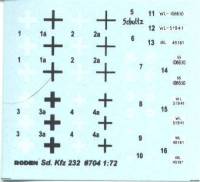 This
is an excellent small scale armor series of models, ones that don't require
a lot of work. While there are some aspects of the model Roden took some
short cuts with (for example the mufflers on the rear of the fenders),
those short cuts don't deter too much from the model, plus it allows the
super detailers to go to work. Highly recommended. This
is an excellent small scale armor series of models, ones that don't require
a lot of work. While there are some aspects of the model Roden took some
short cuts with (for example the mufflers on the rear of the fenders),
those short cuts don't deter too much from the model, plus it allows the
super detailers to go to work. Highly recommended.
Our thanks to Roden and Squadron
for the review kit.
|









|
